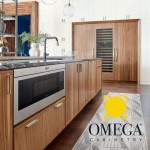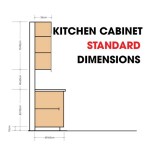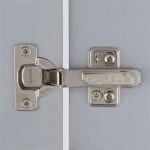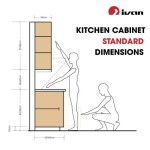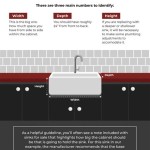How Much Does An Average Kitchen Cost To Fit?
Remodeling a kitchen is a significant investment for homeowners. The kitchen serves as the heart of the home, and its functionality and aesthetics greatly impact daily life and property value. Understanding the cost involved in fitting a new kitchen is crucial for planning and budgeting effectively. While the term "average" can be misleading due to the numerous factors impacting pricing, this article aims to provide a comprehensive overview of the costs associated with fitting an average kitchen, breaking down the expenses and exploring the various elements that influence the final price.
The cost of fitting a kitchen is not a fixed figure. It varies widely depending on factors such as the size of the kitchen, the quality of materials used, the complexity of the design, the extent of structural work involved, the geographic location, and the choice of professional or DIY installation. To provide a realistic understanding, it's important to consider the different tiers of kitchen renovations, from budget-friendly upgrades to high-end, custom designs.
A budget kitchen fitting typically involves replacing existing cabinets and appliances with more affordable options, perhaps with minimal changes to the layout. A mid-range kitchen fitting usually entails a more comprehensive renovation, including new appliances, countertops, and potentially some structural alterations. A high-end kitchen fitting incorporates custom cabinetry, premium appliances, and significant design features, possibly involving substantial structural changes and specialized tradespeople.
Cabinetry Costs: The Foundation of the Kitchen
Cabinetry constitutes a significant portion of the overall kitchen fitting cost. The price range varies considerably based on the material, style, and construction. Stock cabinets, often prefabricated in standard sizes, are the most budget-friendly option. Semi-custom cabinets offer more flexibility in terms of sizing and style options, while custom cabinets are built to exact specifications, allowing for complete design control but at a higher price point.
The material used for the cabinet boxes and doors also impacts the cost. Options range from particleboard or MDF (Medium-Density Fiberboard) with laminate finishes to solid wood. Solid wood cabinets, particularly those made from hardwoods like oak, maple, or cherry, are typically the most expensive, offering durability and aesthetic appeal. Laminate cabinets are more affordable and provide a range of colors and finishes, while thermofoil cabinets are made from MDF wrapped in a layer of vinyl.
Installation costs for cabinetry also need to be considered. Professional installation is recommended to ensure proper alignment and functionality. The complexity of the installation, such as the need for custom fitting or the presence of irregular wall angles, can influence the labor cost. It’s important to obtain quotes from multiple installers to compare pricing and experience.
Beyond the basic cabinets, additional features like pull-out shelving, soft-close hinges, and specialized storage solutions can add to the overall cost. While these features enhance functionality and convenience, they can also have a notable impact on the budget. Planning carefully and prioritizing essential features can help manage expenses.
Countertop Costs: Functionality and Aesthetics
Countertops are another crucial element of the kitchen and a significant cost driver. The choice of material largely determines the expense, with options ranging from laminate and butcher block to granite, quartz, and marble. Laminate countertops are the most affordable, offering a wide range of colors and patterns, but they are less durable than other options.
Granite and quartz countertops are popular choices due to their durability, heat resistance, and aesthetic appeal. Granite is a natural stone, each slab unique in its veining and color. Quartz is an engineered stone, offering consistent color and pattern options and requiring less maintenance than granite. Marble is a luxurious option, prized for its elegant veining, but it is more porous and susceptible to staining than granite or quartz.
Butcher block countertops are made from solid wood, providing a warm and natural look. They require regular maintenance, including oiling to prevent drying and cracking. Concrete countertops offer a modern and industrial aesthetic, but they can be prone to staining and cracking if not properly sealed. Solid surface countertops, such as Corian, are non-porous and seamless, offering easy maintenance and a variety of color options.
The cost of countertop installation depends on the material and the complexity of the installation. Granite, quartz, and marble require professional installation due to their weight and the need for precise cuts and seams. The cost of installation also includes the fabrication of the countertop, including cutting, polishing, and edging. Special features like backsplashes and integrated sinks can add to the installation cost.
Appliance Costs: Essential Functionality
Kitchen appliances represent another significant expenditure in a kitchen fitting project. The cost of appliances varies widely based on brand, model, features, and energy efficiency. A basic appliance package typically includes a refrigerator, oven, cooktop, dishwasher, and microwave. Higher-end appliances may include features like smart technology, professional-grade performance, and specialized functions.
Refrigerators range in price from basic top-freezer models to high-end French-door or built-in refrigerators with advanced features like water and ice dispensers, temperature controls, and smart connectivity. Ovens can range from standard electric or gas ovens to convection ovens, steam ovens, and combination ovens with multiple cooking functions. Cooktops can be electric, gas, or induction, with varying burner configurations and features.
Dishwashers range in price based on features like cycle options, noise level, and energy efficiency. Microwaves can be countertop models, over-the-range models, or built-in models. Selecting energy-efficient appliances can result in long-term savings on utility bills, but they typically have a higher upfront cost. It’s important to consider both the purchase price and the operating costs when selecting appliances.
Installation costs for appliances vary depending on the type of appliance and the existing infrastructure. Refrigerators typically require minimal installation, while ovens and cooktops may require electrical or gas connections. Dishwashers require plumbing and electrical connections. Some appliances may require professional installation to ensure proper functionality and safety. It's important to factor in these costs when budgeting for appliances.
Labor Costs: Hiring Professionals
Labor costs encompass the expenses associated with hiring professionals to perform various tasks related to the kitchen fitting. These tasks can include demolition of the old kitchen, plumbing, electrical work, carpentry, drywall repair, painting, flooring installation, and countertop installation. The cost of labor varies depending on the geographic location, the experience of the tradespeople, and the complexity of the project.
Plumbing work may involve relocating pipes for sinks, dishwashers, and refrigerators with water dispensers. Electrical work may involve installing new outlets, wiring for appliances, and installing lighting fixtures. Carpentry may involve framing walls, installing cabinets, and building custom features. It is essential to hire licensed and insured plumbers and electricians to ensure compliance with local building codes and safety standards.
Demolition costs can vary depending on the extent of the demolition and the disposal requirements. Removing existing cabinets, countertops, and flooring can be labor-intensive. Drywall repair and painting may be necessary after demolition or when making structural changes. Flooring installation can involve laying tile, wood, laminate, or vinyl flooring.
Obtaining multiple quotes from different contractors is crucial for comparing pricing and evaluating experience. It is important to ask for references and review past projects to assess the quality of workmanship. A detailed contract outlining the scope of work, payment schedule, and timeline is essential for avoiding misunderstandings and ensuring a successful project.
Additional Costs: Hidden Expenses
Beyond the major expenses, there are often additional costs associated with kitchen fitting that homeowners may not initially consider. These hidden expenses can include building permits, structural modifications, disposal fees, unexpected repairs, and design fees. Building permits are required for certain types of kitchen renovations, such as structural changes, plumbing modifications, and electrical work. Failure to obtain the necessary permits can result in fines and delays.
Structural modifications may be necessary if the layout of the kitchen is being significantly altered. This can involve moving walls, adding or removing windows, or reinforcing the floor. Structural work requires the expertise of a qualified contractor and may increase the overall cost of the project.
Disposal fees cover the cost of removing and disposing of old cabinets, appliances, and construction debris. These fees can vary depending on the volume of waste and the disposal regulations in the area. Unexpected repairs may arise during the renovation process, such as discovering hidden plumbing or electrical issues. It’s prudent to allocate a contingency fund to cover unexpected expenses.
Design fees may be incurred if a professional kitchen designer is hired to create the kitchen layout and select materials. A designer can help optimize the space, improve functionality, and create a cohesive aesthetic. While design fees add to the upfront cost, they can result in a more satisfying and efficient kitchen in the long run.
In summary, determining how much an average kitchen costs to fit requires careful consideration of several factors. Cabinetry, countertops, appliances, labor, and additional expenses all contribute to the total cost. While it's difficult to provide a precise number without specific details about the project, understanding the cost ranges for each element can help homeowners develop a realistic budget and make informed decisions.

Kitchen Installation Cost 2024 Data

How Much Does A Kitchen Remodel Cost Forbes Home

Kitchen Installation Cost 2024 Data

The Cost Of A Kitchen Remodel Understanding Your Budget

Average Cost To Replace Cabinets Forbes Home

How Much Does A Kitchen Remodel Cost 2024 Average

What Is The Average Kitchen Cabinet Cost

How Much Does A Small Kitchen Remodel Cost 2024 Forbes Home

How Much Does It Cost To Install Kitchen Cabinets Az Cabinet Company

How Much Does A Kitchen Remodel Cost 2024 Data Angi
Related Posts

